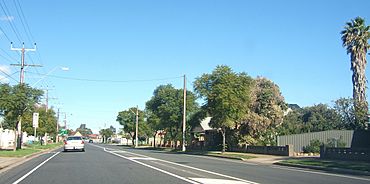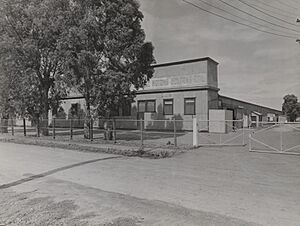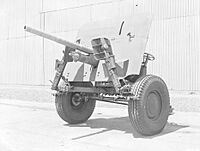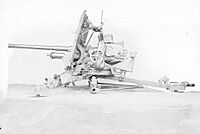Beverley, South Australia facts for kids
Quick facts for kids BeverleyAdelaide, South Australia |
|||||||||||||||
|---|---|---|---|---|---|---|---|---|---|---|---|---|---|---|---|

East Avenue, Beverley
|
|||||||||||||||
| Established | 1849 | ||||||||||||||
| Postcode(s) | 5009 | ||||||||||||||
| Location | 6.1 km (4 mi) NW of Adelaide city centre | ||||||||||||||
| LGA(s) | City of Charles Sturt | ||||||||||||||
| State electorate(s) | Cheltenham | ||||||||||||||
| Federal Division(s) | Hindmarsh | ||||||||||||||
|
|||||||||||||||
Beverley is a suburb located in the western part of Adelaide, South Australia. It is part of the City of Charles Sturt area. This suburb has a rich history, especially with its role in manufacturing and supporting Australia during World War II.
Contents
Exploring Beverley's Location
Beverley is mostly surrounded by important roads. These include Port Road, East Avenue, Ledger Road, and Grange Road. These roads help connect Beverley to other parts of Adelaide.
Beverley's Past: A Look at History
The area we now call Beverley was first planned in 1849. It was created for Edward Stevens by John Morphett. Beverley also includes an older area called York.
In the past, Beverley was home to several important factories.
- Crompton and Sons had a business that worked with animal skins and made fertiliser.
- Pope Products Ltd. was another big company on Princess Street.
- Adelaide Potteries Ltd. made pottery on Toogood Avenue.
- There were also many independent brick-making businesses.
The Beverley Post Office was open for a short time, from 1881 to 1901.
The GM Holden Factory in Beverley
One of the most famous businesses in Beverley was the GM Holden factory. Holden took control of the Beverley site on January 1, 1927. They started their operations on Howards Road.
The Beverley factory didn't build entire cars. Instead, it focused on making important parts for car bodies. It also handled all the blacksmithing work for other Holden workshops. Engineers at Beverley were also in charge of making special parts like ball sockets and hood frames.
Beverley's Role in World War II
When World War II started in September 1939, the Australian Government bought the small Holden plant in Beverley. This factory became very important for the war effort. It was used to make weapons for the Australian Government.
The Beverley plant assembled different types of artillery guns:
- 2-pounder anti-tank guns and their carriages.
- 6-pounder anti-tank guns and their carriages.
- Polsten 20mm anti-aircraft guns and their mounts.
During the war, anti-tank guns were urgently needed. The British army had only a few of these guns. Australia needed 1000 complete guns quickly. The Beverley plant helped meet this demand.
In June 1940, a test version of the 2-pounder anti-tank gun arrived in South Australia. This was just three weeks after the Battle of Dunkirk. Local businesses helped make the parts. After assembly, the guns were thoroughly tested by the military. They passed all the tests, showing Australia's strong manufacturing skills.
What Happened to the GMH Plant After the War?
After the war ended, in 1946, the Beverley plant was sold. Clarkson Ltd, an old company from the city, bought it. They moved their glass treatment business to Beverley. Clarkson's owned the property until 1974.
Later, the property was sold to Arrow Properties Pty Ltd. Clarkson continued to rent the building for three more years. Today, the land is owned by Harlaxton Pty Ltd and is used by ADRAD Pty Ltd.
Who Lives in Beverley? (Demographics)
The 2021 Census counted 1,578 people living in Beverley. The average age of residents was 36 years old.
- About 3.2% of people identified as Aboriginal and/or Torres Strait Islander.
- Most residents (66.9%) were born in Australia.
- Other common birthplaces include India (2.6%), England (3.6%), Italy (0.6%), Vietnam (1.0%), and Philippines (1.2%).
When it comes to religion:
- 38.4% of residents said they had "No religion".
- 20.0% were Catholic.
- 2.1% were Eastern Orthodox.
- 0.8% followed Sikhism.
About 55.9% of the population worked full-time.
Community Life in Beverley
Schools in the Area
St Michael's College is a local independent Catholic high school. It serves students from years 6 to 12. You can find it on East Avenue.
Fun Places and Facilities
Adelaide Arena
Adelaide Arena is a large indoor basketball stadium. It is located between William Street and Toogood Avenue. The arena can hold up to 8,000 people. It was built in 1991. It is the home court for Adelaide's professional basketball teams, the Adelaide 36ers (men's) and the Adelaide Lightning (women's).
Parks to Enjoy
The only park within Beverley is called Toogood Reserve. It's a great spot for outdoor activities.
Getting Around Beverley (Transportation)
Main Roads
Beverley is well-connected by major roads. Port Road links the suburb to Port Adelaide and the Adelaide city centre. Grange Road forms part of Beverley's southern border. East Avenue, on the eastern side, connects Port and Grange roads.
Public Transport
Public transport in Beverley is provided by the Adelaide Metro. This makes it easy for residents to travel around the city using buses.




